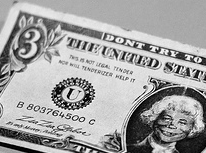 In the big book of Folktales for money managers you’ll find this delightful story. It begins, as folktales do, when a stranger comes to town. As he checks into the hotel he asking Albert the desk clerk to store ten thousand dollars the money safely in the hotel safe. But Albert takes the money and pays off a debt to Bob. This triggers a cascade. Bob pays off a debt to Charlie, Charlie to Dave, etc. Later that evening Zed steps into the hotel and pays off a debt he owes to Albert. Greatly relieved Al then places the money into the safe. The next morning the stranger is chatting with Albert and reveals he’s a Fed. As he is retrieving his cash he jokes: “Man, these are lousy these counterfeit notes!”
In the big book of Folktales for money managers you’ll find this delightful story. It begins, as folktales do, when a stranger comes to town. As he checks into the hotel he asking Albert the desk clerk to store ten thousand dollars the money safely in the hotel safe. But Albert takes the money and pays off a debt to Bob. This triggers a cascade. Bob pays off a debt to Charlie, Charlie to Dave, etc. Later that evening Zed steps into the hotel and pays off a debt he owes to Albert. Greatly relieved Al then places the money into the safe. The next morning the stranger is chatting with Albert and reveals he’s a Fed. As he is retrieving his cash he jokes: “Man, these are lousy these counterfeit notes!”
Apparently this town was entangled in $270,000 worth of debt, but it took only $10,000 to unwind the problem.
When I originally read this story in a fun pamphlet on local script currency systems it triggered a reminding of an old Mad Magazine bit. Kids in high school all trying to act like the next coolest kid. They too were caught in an analogous cycle. It’s delightful the way the mind works; Mad Magazine, Mad Money… tis a slight relief: after skimming this piece. Apparently the global village is entangled in a similar cascade of interlocking debt. Sum it all up, divide by the village population, and what do you get? Every human on the planet has $190,000 of derivatives debit.
In the folktale the $270,000 of debt is unwound in a few hours with no transaction costs, no friction, and apparently no interest payments. We should be so lucky.
Pingback: (mit hacksause)
Yes unfortunately the linked article makes the assumption that the notional amount of derivative contracts means something.
Saying that every human has $190k of derivatives debt is rather like saying that because there are (at a guess) 200 million drivers in the US and EU, and the maximum possible auto insurance claim is about $1M if a driver loses control and drives into a crowd of people, then there must be 200 TRILLION DOLLARS WORTH OF INSURANCE DEBT JUST FOR CARS ALONE! EVERYBODY PANIC!
In reality a much more realistic gauge of the size of the derivatives is the market value, in the same way that the size of the insurance markets is normally measured in premium (which should have some relation to expected claims + costs).
A $1M interest rate swap is just that – a series of payments of the difference between the current rate of interest and a pre-determined fixed rate. If one party stops paying, the maximum loss is the difference of the rates for the rest of the term of the contract. Nobody ever has an obligation to pay the $1M notional (hence the name “notional”).
In addition many contracts are offsetting – if xxx company enters into a contract with a bank, the bank can’t pitch up one day and say “hey, whether you like it or not your contract is now with yyy company who you have never heard of who needed a similar but opposite contract”. Instead it will enter into a second offsetting contract with yyy. This mode of operation leads the notionals to blow up while the total market values remain limited.
As an example, the total notional credit default swaps on Lehman Brothers was $72B and the payout was nearly the maximum possible, but the actual cash exchanged was only $5B in the end because many of the contracts were offsetting.
I’ve also got no idea where the figure for “listed credit derivatives” comes from. If you look at the BIS statistics release (page 108) they mention about $28 B notional in exchange-traded futures and $51 B notional in options (but again, notional is not very meaningful). There are no listed credit derivatives at the moment, as there are technical problems with trading them on an exchange.